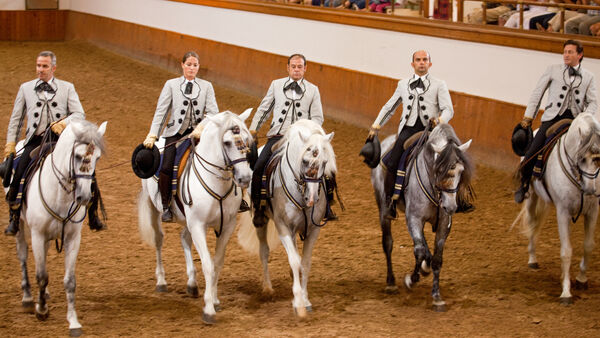Going to the Dogs (and Other Animals) in Europe
By Rick Steves

Despite a lifetime of European travel, there is a world of firsts still out there for me. Recently, for example, I had my first experience with falconry.
It was at Ireland's School of Falconry (just outside of Cong, north of Galway), where a great guide took our tour group on a "hawk walk." For about an hour, we wandered through the enchanting grounds of Ashford Castle, with our guide sporting a Harris hawk on his forearm. After learning about falconry, each person in our group got an opportunity to toss and catch a bird on his or her arm. With each toss, the glove was rotated to the next person and the guide tucked a little chicken meat in the padded palm — and the hawk knew just where to return. The experience was both intimate and intense.
Throughout Europe, you can find vivid and memorable animal demonstrations and experiences. They run the gamut, from famous festivals (Spain's Running of the Bulls or Siena's Palio horse race) to routine rituals (sheep shearing or dog feeding). Whether big and raucous or small and intimate, I always find these experiences fascinating.
In Vienna, a cultural highlight is seeing the Lipizzaner stallions perform at the magnificent Spanish Riding School. These regal white horses are a creation of Habsburg Archduke Charles, who imported Andalusian horses from Habsburg-ruled Spain and then mated them with a local line. They're known for their noble gait and Baroque profile.
One Sunday morning, I decided to drop in on one of their performances in the chandeliered Baroque riding hall at the heart of the city, adjacent to the grand imperial Hofburg palace. I paid about €25 for a standing-room spot (seats cost much more — too much, to my mind) to see the much-loved stallions prance through their choreographed moves to jaunty Viennese classical music.
Equally impressive is the horse show at the Royal Andalusian School of Equestrian Art in Jerez, Spain. Here, horses — both purebred Spanish horses and larger mixed breeds — perform an equestrian ballet with choreography, purely Spanish music, and costumes from the 19th century. The stern riders command their talented, obedient steeds to prance, jump, hop on their hind legs, and do-si-do in time to the music.
While I appreciate the elegance and grandeur of a horse show, I also love the rustic simplicity and intimacy of a sheepdog demonstration.
At Kissane Sheep Farm, a 2,500-acre farm perched on a scenic slope above Ireland's Black Valley (near Killarney), John Kissane's family has been raising sheep for five generations. Visitors get to chat with the family and learn about their livelihood, and then watch highly strung sheepdogs race around according to John's call. On my most recent visit, one of the brothers explained to me — while effortlessly sheering a sheep — that, since the Irish wool industry is so bad these days, their farm survives only thanks to the money generated by showing off the tradition to visiting tourists. (While they normally do demonstrations just for tour groups, independent travelers are welcome to join a scheduled demo — just call ahead for times.)
And at Working Sheepdogs near Inverness, Scotland, a dozen joyous border collies seem to thrill to show off their skills to visitors. The shepherd here begins with a short talk on the background of keeping sheep, then demonstrates how he commands his eager collies. Watching each dog respond with precision to individual commands of whistles and shouts is impressive. On this farm, it was very clear: Sheepdogs are smart — and sheep are idiots.
The best animal shows are not only interesting and educational, but also vividly real and culturally broadening — giving insights into generations-old traditions and different ways of life.

